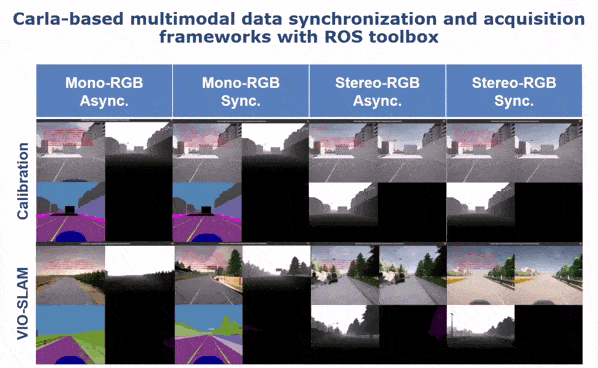IBISCape: A Simulated Benchmark for multi-modal SLAM Systems Evaluation in Large-scale Dynamic Environments
Are you interested to use IBISCape data acquisition frameworks, or to evaluate your new SLAM system on IBISCape benchmark in an academic work ! Thanks for citing the following paper:
@Article{IBISCape22,
author={Soliman, Abanob and Bonardi, Fabien and Sidib{\'e}, D{\'e}sir{\'e} and Bouchafa, Samia},
title={{IBISCape}: A Simulated Benchmark for multi-modal {SLAM} Systems Evaluation in Large-scale Dynamic Environments},
journal={Journal of Intelligent {\&} Robotic Systems},
year={2022},
month={Oct},
day={19},
volume={106},
number={3},
pages={53},
issn={1573-0409},
doi={10.1007/s10846-022-01753-7},
url={https://doi.org/10.1007/s10846-022-01753-7}
}
To run any of our acquisition frameworks, make sure you have:
- CARLA installed version up to 0.9.11 CARLA installation repository.
IBISCape frameworks are tested on CARLA versions: 0.9.10, 0.9.10.1, and best performance with 0.9.11.
- OpenCV any version OpenCV installation repository.
- Clone our IBISCape repository in a folder next to your CARLA installation directory and check the (.egg) file imported in all the frameworks to be similar to your installation Check this link.
- Our new Calibration targets added to CARLA-Town3 can be downloaded from this link.
- Add our CARLA calibration town to the Map content folder to your CARLA installation directory
/your_CARLA_directory/carla/Unreal/CarlaUE4/Content/Carla/Maps/. - Then, open the CARLA-Unreal Engine interface and press Compile, Build and finally Play.
- Run one of our 6 data acquisition frameworks:
(full_sensor_setup),(rgb_depth),(imu),(lidar_svo),(stereo_dvs_imu), and(stereo_rgb_imu).
$ python3 framework_name.py- We performed the stereo RGB-IMU calibration using kalibr, and all the configuration .yaml files are added to the yaml_config_files folder. (Also, configuration files for EVO, ESVO, BASALT and ORB-SLAM3)
The calibration data acquisition is done manually, where the user can collect sequences with all the movements specific to his application.
- Play your desired CARLA-town, then run one of our 5 data acquisition frameworks:
(full_sensor_setup),(rgb_depth),(lidar_svo),(stereo_dvs_imu), and(stereo_rgb_imu).
$ python3 framework_name.py- All sensors readings in the stereo-RGB are timestamped with the world tick, while for the mono-RGB the readings are timestamped according to the sensor local tick.
- To add people and cars to the scene, run the spawn_npc.py script in a new terminal and then close it ctrl+c. This will spawn people and cars to your Carla-client as additional actors.
- The 43 calibration and SLAM sequences for all available CARLA-towns in highly dynamic weather can be downloaded from these links: calibration, SLAM+Evaluation, and Configuration.
The VIO-SLAM data acquisition is done using CARLA autopilot, following its traffic manager to perfectly simulate the real world.
- Here we developed some python scripts to help in creating ROS bags for ROS-based calibration and odometry frameworks with the right and synchronized timestamping.
- Also, some additional scripts to read the rosbags, convert all RGB images in sequence folder to grayscale images, and associating the RGB with the corresponding depth maps.
